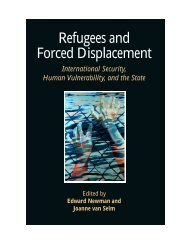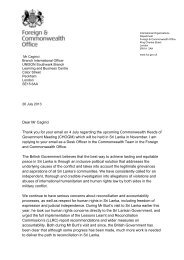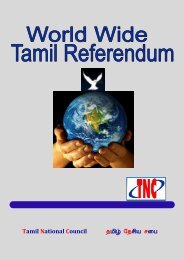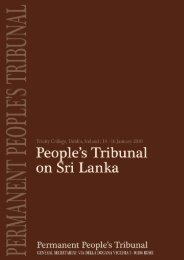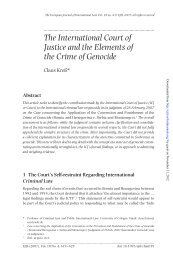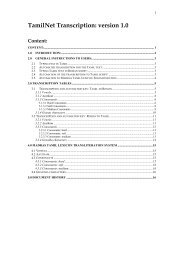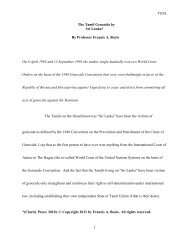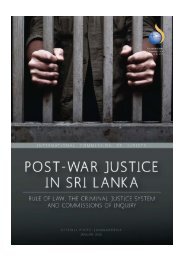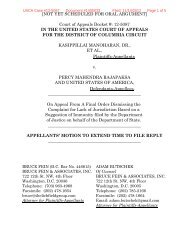Proposal to encode characters for Extended Tamil §1 ... - TamilNet
Proposal to encode characters for Extended Tamil §1 ... - TamilNet
Proposal to encode characters for Extended Tamil §1 ... - TamilNet
You also want an ePaper? Increase the reach of your titles
YUMPU automatically turns print PDFs into web optimized ePapers that Google loves.
<strong>Proposal</strong> <strong>to</strong> <strong>encode</strong> <strong>characters</strong> <strong>for</strong> <strong>Extended</strong> <strong>Tamil</strong>Shriramana Sharma, jamadagni-at-gmail-dot-com, India2010-Jul-10This document requests the encoding of <strong>characters</strong> which are required <strong>to</strong> enable the <strong>Tamil</strong>script <strong>to</strong> support the writing of Sanskrit. It repeats some relevant sections from my Granthaproposal L2/09-372 and my feedback document L2/10-085. It also contains some morein<strong>for</strong>mation and citations and is a <strong>for</strong>mal proposal <strong>for</strong> the encoding of those <strong>characters</strong>.<strong>§1</strong>. IntroductionIt is well known that the <strong>Tamil</strong> script has an insufficient character reper<strong>to</strong>ire <strong>to</strong> representthe Sanskrit language. Sanskrit can be and is written and printed quite naturally in mos<strong>to</strong>ther (major and some minor) Indian scripts, which have the required number of<strong>characters</strong>. However, it cannot be written in plain <strong>Tamil</strong> script without some contrivedextensions acting in the capacity of diacritical marks, just as it cannot be written in theLatin script without the usage of diacritical marks (as prescribed by ISO 15919 or IAST).Another option is <strong>to</strong> import written <strong>for</strong>ms from another script (<strong>to</strong> be specific, Grantha,<strong>Tamil</strong>’s closest Sanskrit-capable relative) <strong>to</strong> cover the remaining unsupported sounds.We call this version of <strong>Tamil</strong> that has been extended <strong>to</strong> support Sanskrit as<strong>Extended</strong> <strong>Tamil</strong>. It should be noted that this is neither a distinct script from <strong>Tamil</strong> nor canit be considered a mixture of two scripts (<strong>Tamil</strong> and Grantha), because the ‘grammar’ of thescript (i.e. the orthographic rules, such as those of <strong>for</strong>ming consonant clusters) is still tha<strong>to</strong>f <strong>Tamil</strong>. Thus <strong>Extended</strong> <strong>Tamil</strong> may be likened <strong>to</strong> the IPA extensions <strong>to</strong> the Latin script <strong>to</strong>denote sounds that the Latin script does not natively denote or differentiate.There exists a large amount of printed material in the <strong>Tamil</strong> script showing bothkinds of <strong>Extended</strong> <strong>Tamil</strong> (i.e. one using diacritic marks and one importing <strong>for</strong>eign symbols)handling the Sanskrit-capability problem (while printings importing Grantha written <strong>for</strong>msare somewhat rare and mostly not of recent date). The present proposal is <strong>to</strong> <strong>encode</strong> inUnicode those <strong>characters</strong> that are needed <strong>to</strong> support Sanskrit writing in <strong>Tamil</strong>.Since the apparent “mixture” of the Grantha script in <strong>Extended</strong> <strong>Tamil</strong> is only in thatversion of <strong>Extended</strong> <strong>Tamil</strong> which chooses importing over diacritics, the borrowing ofGrantha written <strong>for</strong>ms is optional. There<strong>for</strong>e there should be no problem in considering<strong>Extended</strong> <strong>Tamil</strong> <strong>characters</strong> <strong>for</strong> encoding quite independent of the encoding of Grantha.1
Currently (even as of 5.2) the Unicode standard (§9.6, p 289) prescribes the use ofsuperscript <strong>characters</strong> 00B2, 00B3 and 2074 <strong>to</strong> handle <strong>Extended</strong> <strong>Tamil</strong>. However, we shallshow that while the glyphs these <strong>characters</strong> supply may be indeed used as diacritics, thereexist problems which necessitate the encoding of separate <strong>characters</strong>.§2. Characters that are needed <strong>for</strong> <strong>Extended</strong> <strong>Tamil</strong>The <strong>Tamil</strong> script does not have <strong>characters</strong> <strong>for</strong> vocalic R, RR, L and LL (dependent andindependent). It has only one non-nasal consonant per class among the class consonantswhereas the other Sanskrit-supporting scripts like Devanagari and Grantha have four,leaving three consonants missing per class. The exception is CA-class where two <strong>characters</strong>– CA and JA – are already present in <strong>Tamil</strong> and only CHA and JHA are missing. <strong>Tamil</strong> alsodoes not have an anunasika sign, anusvara, visarga, ardhavisarga, danda-s and avagraha.However, since the danda-s from 0964 and 0965 and the ardhavisarga from 1CF2(and the newly-proposed rotated version at 1CF3) are being used <strong>for</strong> all Indic scripts, these<strong>characters</strong> do not need <strong>to</strong> be duplicated <strong>for</strong> <strong>Extended</strong> <strong>Tamil</strong>.Thus, <strong>to</strong> extend the <strong>Tamil</strong> script <strong>to</strong> represent Sanskrit, one needs <strong>to</strong> <strong>encode</strong><strong>characters</strong> <strong>for</strong> vocalic R etc, the missing class consonants and then the anunasika sign etc.Thus those <strong>characters</strong> that need <strong>to</strong> be <strong>encode</strong>d <strong>for</strong> <strong>Extended</strong> <strong>Tamil</strong> are:1) TAMIL EXTENDED LETTER VOCALIC R2) TAMIL LETTER VOCALIC RR3) TAMIL LETTER VOCALIC L4) TAMIL LETTER VOCALIC LL5) TAMIL VOWEL SIGN VOCALIC R6) TAMIL VOWEL SIGN VOCALIC RR7) TAMIL VOWEL SIGN VOCALIC L8) TAMIL VOWEL SIGN VOCALIC LL9) TAMIL LETTER KHA10) TAMIL LETTER GA11) TAMIL LETTER GHA12) TAMIL LETTER CHA13) TAMIL LETTER JHA14) TAMIL LETTER TTHA15) TAMIL LETTER DDA2
16) TAMIL LETTER DDHA17) TAMIL LETTER THA18) TAMIL LETTER DA19) TAMIL LETTER DHA20) TAMIL LETTER PHA21) TAMIL LETTER BA22) TAMIL LETTER BHA23) TAMIL SIGN ANUNASIKA24) TAMIL SIGN SPACING ANUSVARA25) TAMIL SIGN GRANTHA-STYLE VISARGA26) TAMIL SIGN AVAGRAHA§3. Comparison tableThe following table shows the <strong>characters</strong> that are needed <strong>for</strong> the Sanskrit language in fourdifferent script systems. The first two, Devanagari and Grantha are self-evident. The thirdand fourth columns show one version each of the two major versions of <strong>Extended</strong> <strong>Tamil</strong>,which we will call liberal and conservative. The boxes corresponding <strong>to</strong> <strong>characters</strong> thatneed <strong>to</strong> be newly <strong>encode</strong>d <strong>for</strong> <strong>Extended</strong> <strong>Tamil</strong> have been shaded in.Dev. Gran. ET-L ET-C Dev. Gran. ET-L ET-C gA uA uA ◌ ◌g ◌u/◌g ◌u gÅ uÅ uÅ ◌ ◌gå ◌uå ◌uå gI uI uI ◌ ◌ui ◌ui ◌ui g u u ◌ ◌gи ◌uи ◌uи gU uU uU ◌ ◌gu ◌uu ◌uu g u u ◌ ◌g ◌u ◌u gRs gRs i' ◌ ◌grs ◌grs ◌ui'3
gs gs i' ◌ ◌gs ◌gs ◌ui' gLs gLs i' ◌ ◌gls ◌gls ◌ui' gs gs i' ◌ ◌gs ◌gs ◌ui' gE u u ◌ ge◌ u◌ u◌ g u u ◌ g◌ u◌ u◌ gO u u ◌ ge◌gå u◌uå u◌uå g u u ◌ ◌g/ge◌g ue◌u ue◌u gk uk uk gt ut ut g g uk 2 gþ gþ ut 2 gg gg uk 3 gd gd ut 3 g g uk 4 gð gð ut 4 g u u gn un un gc uc uc gp up up gch gch uc 2 g g up 2 gj uj uj gb gb up 3 g g uj 2 g g up 4 g u u gm um um gT uT uT gy uy uy4
gÞ gÞ uT 2 gr ur ur gD gD uT 3 gl ul ul gÐ gÐ uT 4 gL uL uL gN uN uN gv uv uv g u u/uc' gs us us gS uS uS gh uh uh◌ ◌g ◌g ◌g ◌ ◌g ◌g ◌mh'◌ ◌g ◌g ◌: ◌ ◌ ◌ ◌ g g (uA) gg gg (uÅ)There are two points <strong>to</strong> be noted about the above chart. One is that in ET-C (<strong>Extended</strong> <strong>Tamil</strong>conservative version), a character which has already been <strong>encode</strong>d, namely 0BB6 TAMILLETTER SHA, may need <strong>to</strong> take a different glyph from the standard one shown in the Unicodecode chart depending on the orthographic style of the user. The other is that in the sameET-C, the double avagraha (just a sequence of two avagraha-s) will need <strong>to</strong> be rendered as asingle glyph (by a ligature mechanism). I mention this here just <strong>to</strong> note that separate<strong>characters</strong> are not being <strong>encode</strong>d <strong>for</strong> these glyphic variations in <strong>Extended</strong> <strong>Tamil</strong>.§4. Variations in <strong>Extended</strong> <strong>Tamil</strong>We mentioned the two versions of <strong>Extended</strong> <strong>Tamil</strong> – liberal and conservative. (I hasten <strong>to</strong>remark that there are no political over<strong>to</strong>nes here!) These terms merely refer <strong>to</strong> the extent<strong>to</strong> which the new <strong>Extended</strong> <strong>Tamil</strong> <strong>characters</strong> borrow glyphs from Grantha.The liberal version of <strong>Extended</strong> <strong>Tamil</strong> (“ET-L”) imports glyphs from Grantha <strong>for</strong> allthe new <strong>characters</strong> that need <strong>to</strong> be <strong>encode</strong>d <strong>for</strong> <strong>Extended</strong> <strong>Tamil</strong>. The glyphs were shown inthe table above. It also uses Grantha-style glyphs <strong>for</strong> consonants that carry Grantha-stylevowel signs, even if those consonants are already part of the <strong>Tamil</strong> script.5
In the conservative version also, there are many variants. The selection of glyphsshown <strong>for</strong> ET-C in the table in §3 is my personal choice (with SHA taking the Grantha-styleglyph) used by myself in publications edited and translated by myself, such as JagadguruRatna Māla Stava of Sadāśiva Brahmendra and other related works and Saparyā Paryāya Stava ofSadāśiva Brahmendra and other works, both <strong>to</strong> be published by Śrī Sadāśiva BrahmendraBhakta Jana Samiti, Chennai. Another variant is seen at the Indic transliteration websitehttp://tamilcc.org/thoorihai/thoorihai.php (retrieved 2010-Mar). The documenthttp://tamilcc.org/thoorihai/Manual.pdf from that site discusses some more variants. Thefollowing samples from pages 28-31 of Śiva Kavaca and Indrākṣī S<strong>to</strong>tra, published in 1996 byGiri Trading Agency, Chennai, shows yet another particular variant:Finally on discussing variants I should remark that there are many imperfections in realworldbooks, such as not differentiating the consonant /m/ and the anusvara, using theglyph of <strong>Tamil</strong> NNNA <strong>for</strong> NA etc (as seen in the samples above). Some books even go <strong>to</strong> theatrocious (in my reaction as a Sanskrit expert) extent of using bold <strong>for</strong>matting <strong>to</strong> merelydifferentiate between the voiced and voiceless class consonants (with bold denotingvoiced) and not differentiating between the aspirated and unaspirated <strong>for</strong>ms thereof. Theseare imperfections, and cannot be considered legitimate variants in their own right.7
§5. The need <strong>to</strong> <strong>encode</strong> <strong>Extended</strong> <strong>Tamil</strong>While as shown above there do exist many variants, <strong>Extended</strong> <strong>Tamil</strong> is essentially one. It isan extension of the <strong>Tamil</strong> script <strong>to</strong> support Sanskrit, as said at the outset. The particularglyphs used <strong>for</strong> the additional <strong>characters</strong> being used with the native <strong>Tamil</strong> <strong>characters</strong> maydiffer. But whether Grantha-style glyphs are used <strong>for</strong> the additional <strong>characters</strong> or diacriticlikemarks are used with native <strong>Tamil</strong> glyphs, the underlying <strong>characters</strong> are the same. I mayliken this <strong>to</strong> the Old Italic and Brahmi situation where (as I am in<strong>for</strong>med) there are many(seriously different) glyphic variants but the Old Italic and Brahmi scripts are <strong>encode</strong>d asone script each. There<strong>for</strong>e <strong>Extended</strong> <strong>Tamil</strong> may be <strong>encode</strong>d as one with the variants beingtaken care of at the font level.It may be asked what is the need <strong>for</strong> encoding <strong>Extended</strong> <strong>Tamil</strong>, when the existingUnicode recommendation is <strong>to</strong> use the <strong>characters</strong> 00B2, 00B3 and 2074. I however believethat that portion of Unicode does not do justice <strong>to</strong> the real complexity behind <strong>Extended</strong><strong>Tamil</strong>. Some reasons are given below:1) That recommendation disables (or at least makes difficult or less-thanelementary)one-<strong>to</strong>-one transliteration by computer of Sanskrit texts fromDevanagari or other Indic scripts <strong>to</strong> <strong>Tamil</strong>.2) It does not consider the anusvara, visarga, avagraha etc at all (or the vowelsvocalic R etc) but only talks about “consonants”. These <strong>characters</strong> are notanalysed by natives (or <strong>to</strong> my knowledge by others) as consonants.3) It does not consider the problem of rendering pointed out by me in page 11of my document L2/10-085 (Feedback <strong>to</strong> Dr Anderson's Grantha Summary). Agood look at the samples <strong>for</strong> ET-C provided hereinbe<strong>for</strong>e will show that theproblem is genuine and cannot be resolved by existing means. (Note that inthose samples it is not only the superscript digits 2, 3 and 4 but also theapostrophe which gets placed between consonants and their vowel signs.)4) It does not even consider the existence of the variant of <strong>Extended</strong> <strong>Tamil</strong>using Grantha-style glyphs <strong>for</strong> the additional <strong>characters</strong>.To maintain the recommendation, and yet address the problem of point 4 above, it may besuggested that after the encoding of the Grantha script, codepoints from the Grantha blockmay be used <strong>to</strong> achieve Grantha-style glyphs, but such a suggestion should be pronounceddead on arrival because it goes against the essence of Unicode. In Unicode one does not usedifferent <strong>characters</strong> <strong>to</strong> handle glyphic variants but different fonts. I have also discussed8
other problems with this option in page 6 of L2/10-085. (It is also highly probable that thatthe word-boundary problem I have mentioned there also exists with the current Unicoderecommendation of using 00B2 because those <strong>characters</strong> are all GC=No.)There<strong>for</strong>e the cleanest solution is <strong>to</strong> <strong>encode</strong> separate <strong>characters</strong>, with anappropriate selection of representative glyphs (as done <strong>for</strong> Old Italic and Brahmi). It wouldsolve all the problems outlined above and more. All the variants (in both the liberal andconservative versions) can be handled by appropriate fonts and smart font technologies.More is discussed in the rendering section below. I have also mentioned some otheradvantages <strong>to</strong> the separate encoding of <strong>Extended</strong> <strong>Tamil</strong> <strong>characters</strong> in page 8 of L2/10-085.Finally I should say that I must also not <strong>for</strong>get the Saurashtra language, which alsois written with <strong>Extended</strong> <strong>Tamil</strong>. As I neither know the language nor any of its experts, I canonly go by the Saurashtra block code-chart <strong>for</strong> A880-A8DF and the correspondingdescription in TUS 5.2 pp 329-330. The only point that the above discussion centered onSanskrit misses out from the Saurashtra situation seems <strong>to</strong> be the Saurashtra Haaru.However, it seems that it is an analog of the <strong>Tamil</strong> āytam, and hence perhaps may betransliterated by the existing <strong>Tamil</strong> āytam character 0B83 placed appropriately. Further,the Saurashtra language also apparently uses the short E and O sounds (which do not existin Sanskrit) but these can easily be represented (in either ET-L or ET-C) by the existing<strong>encode</strong>d <strong>Tamil</strong> <strong>characters</strong> <strong>for</strong> those sounds.There<strong>for</strong>e, an encoding of <strong>Extended</strong> <strong>Tamil</strong> as described above should also be able <strong>to</strong>support the writing of the Saurashtra language using <strong>Tamil</strong> <strong>characters</strong>.§6. RenderingIn general, all rendering rules are as in <strong>Tamil</strong>, since, as mentioned be<strong>for</strong>e the underlying‘grammar’ (orthography) of <strong>Extended</strong> <strong>Tamil</strong> is still that of <strong>Tamil</strong>. The letters shouldfunction like the normal <strong>Tamil</strong> letters, and the spacing combining marks are all displayed<strong>to</strong> the right of their base. The avagraha is as in other scripts that have it.6.1. General Category propertyOf the <strong>characters</strong> <strong>to</strong> be newly <strong>encode</strong>d <strong>for</strong> <strong>Extended</strong> <strong>Tamil</strong> (see §2) 18 are independentletters (both vowels and consonants, GC=Lo), 4 are Indic vowel signs (GC=Mc), 2 otherspacing combining marks (GC=Mc) and 1 avagraha (GC=Lo).As <strong>for</strong> single remaining character, the anunasika sign, it is <strong>to</strong> be noted that in avariant of ET-C (as described by the Thoorihai PDF mentioned be<strong>for</strong>e), the anunasika sign is9
transliterated by (the glyphic equivalent of) TAMIL MA + TAMIL VIRAMA + SUPERSCRIPT THREE. Ifthe character TAMIL SIGN ANUNASIKA is given GC=Mn, then one must consider how thisvariant is <strong>to</strong> be implemented because the character should then properly get GC=Mc. Mysuggestion is that this character take GC=Mc.For the variants where the character is non-spacing, the situation is <strong>to</strong> be handledlike the TAMIL VOWEL SIGNS U/UU which both have GC=Mc but <strong>for</strong> all native <strong>Tamil</strong>consonants are effectively non-spacing as they ligate with their base. Going by thisargument I have chosen <strong>to</strong> give this character GC=Mc.6.2. Substitution rulesWithin ET-L, there exist two major variants as described above. One system uses Granthastyleglyphs <strong>for</strong> even native <strong>Tamil</strong> consonant <strong>characters</strong> when they take Grantha-style<strong>Extended</strong> <strong>Tamil</strong> vowel signs. It also uses only the Grantha-style virama glyph with Granthastyle<strong>Extended</strong> <strong>Tamil</strong> consonants even though the virama character <strong>to</strong> be used in theUnicode representation of <strong>Extended</strong> <strong>Tamil</strong> is the <strong>Tamil</strong> virama. Another system does notuse Grantha-style glyphs <strong>for</strong> native <strong>Tamil</strong> consonant <strong>characters</strong> and uses the <strong>Tamil</strong>-stylevirama glyphs <strong>for</strong> even Grantha-style consonants. These two versions may be handled bysmart-font rendering by the turning on or off of the following two rules:TAMIL CONSONANT + TAMIL EXTENDED VOWEL SIGN → GRANTHA CONSONANT + GRANTHA VOWEL SIGNTAMIL EXTENDED CONSONANT + TAMIL VIRAMA → GRANTHA CONSONANT + GRANTHA VIRAMAI have also already mentioned that in (at least one variant of) ET-C, the double avagrahawould have <strong>to</strong> be handled as follows:TAMIL EXTENDED SIGN AVAGRAHA →LEFT PARANTHESIS + TAMIL LETTER A + RIGHT PARANTHESISTAMIL EXTENDED SIGN AVAGRAHA + TAMIL EXTENDED SIGN AVAGRAHA →LEFT PARANTHESIS + TAMIL LETTER AA + RIGHT PARANTHESIS6.3. Consonant clustersFor consonant clusters in which <strong>Tamil</strong> <strong>Extended</strong> consonants are involved, there is noligature <strong>for</strong>mation except <strong>for</strong> K·SSA which is already present in <strong>Tamil</strong>. This ligature may berendered <strong>Tamil</strong>-style or Grantha-style, the minute difference being in the bot<strong>to</strong>m leftquadrant of the glyph. There are no conjoining <strong>for</strong>ms. While the question itself does notarise in ET-C, it does arise in ET-L where Grantha-style consonants are present. However,10
except <strong>for</strong> the single ligature K·SSA, consonants are written with visible virama asappropriate (in one variant of ET-L with Grantha-style virama glyph <strong>for</strong> Grantha-styleconsonants not existing in <strong>Tamil</strong> and <strong>Tamil</strong>-style <strong>for</strong> native <strong>Tamil</strong> consonants).§7. Collation and linebreakingAs the language being represented is Sanskrit, the Sanskrit collation order (described indetail in my Grantha proposal L2/09-372 <strong>§1</strong>0) is <strong>to</strong> be followed. It is <strong>to</strong> be remembered thatnative <strong>Tamil</strong> <strong>characters</strong> and newly <strong>Tamil</strong> <strong>Extended</strong> <strong>characters</strong> which be naturally mixed upin the sorting order. The rules <strong>for</strong> line breaking are as in <strong>Tamil</strong>.§8. Unicode character properties8.1. DiscussionI have already discussed in L2/10-085 whether <strong>to</strong> <strong>encode</strong> these <strong>characters</strong> in the <strong>Tamil</strong>block or elsewhere. Since the positions in the <strong>Tamil</strong> block corresponding <strong>to</strong> the ‘missing’<strong>characters</strong> from other blocks are yet empty, it would be very easy <strong>to</strong> simply fill in thosecodepoints. However, I strongly suspect that it would not be welcomed by some parties thatare already asking <strong>for</strong> the removal of Grantha-style <strong>characters</strong> from the <strong>Tamil</strong> block (whichis of course absurd). There<strong>for</strong>e, <strong>to</strong> avoid such a problem, these <strong>characters</strong> may be <strong>encode</strong>din a separate “<strong>Tamil</strong> <strong>Extended</strong>” block (just like “Devanagari <strong>Extended</strong>”), another name <strong>for</strong>the <strong>Tamil</strong> Supplementary block I requested in L2/09-317. They may be placed sequentially.Regarding the character names, I felt that it is better <strong>to</strong> name these <strong>characters</strong>beginning with the words TAMIL EXTENDED and not just TAMIL. However, as per instructionsfrom the UTC I have used just TAMIL. For the anusvara and visarga, however, I had <strong>to</strong>introduce the adjectives SPACING and GRANTHA-STYLE <strong>to</strong> differentiate them from the existing“anusvara” and “visarga” <strong>characters</strong> in the <strong>Tamil</strong> block 0B82 and 0B83.There is only one point about naming I would like <strong>to</strong> mention, however. Everywhereelse (Devanagari, Gujarati etc), the anunasika sign has been named SIGNCANDRABINDU and not SIGN ANUNASIKA. Here, however, I request <strong>for</strong> the anunasikacharacter <strong>to</strong> be named anunasika and not candrabindu. The reason is that, as I havementioned above, there are many variants <strong>to</strong> <strong>Extended</strong> <strong>Tamil</strong>, and not all of them use thecandrabindu <strong>for</strong> the anunasika, as I have remarked above in §6.1. There<strong>for</strong>e, it would not beappropriate this character CANDRABINDU, and there<strong>for</strong>e I ask <strong>for</strong> it <strong>to</strong> be named TAMILEXTENDED SIGN ANUNASIKA.11
The script property of these <strong>characters</strong> should be script=tamil <strong>to</strong> enable theirpainless use among <strong>Tamil</strong> <strong>characters</strong>, since, as is being several times repeated, it is still the<strong>Tamil</strong> script which is but being extended.8.2. Properties listingxx00;TAMIL SIGN ANUNASIKA;Mc;0;L;;;;;N;;;;;xx01;TAMIL SIGN SPACING ANUSVARA;Mc;0;L;;;;;N;;;;;xx02;TAMIL SIGN GRANTHA-STYLE VISARGA;Mc;0;L;;;;;N;;;;;xx03;TAMIL LETTER VOCALIC R;Lo;0;L;;;;;N;;;;;xx04;TAMIL LETTER VOCALIC RR;Lo;0;L;;;;;N;;;;;xx05;TAMIL LETTER VOCALIC L;Lo;0;L;;;;;N;;;;;xx06;TAMIL LETTER VOCALIC LL;Lo;0;L;;;;;N;;;;;xx07;TAMIL LETTER KHA;Lo;0;L;;;;;N;;;;;xx08;TAMIL LETTER GA;Lo;0;L;;;;;N;;;;;xx09;TAMIL LETTER GHA;Lo;0;L;;;;;N;;;;;xx0A;TAMIL LETTER CHA;Lo;0;L;;;;;N;;;;;xx0B;TAMIL LETTER JHA;Lo;0;L;;;;;N;;;;;xx0C;TAMIL LETTER TTHA;Lo;0;L;;;;;N;;;;;xx0D;TAMIL LETTER DDA;Lo;0;L;;;;;N;;;;;xx0E;TAMIL LETTER DDHA;Lo;0;L;;;;;N;;;;;xx0F;TAMIL LETTER THA;Lo;0;L;;;;;N;;;;;xx10;TAMIL LETTER DA;Lo;0;L;;;;;N;;;;;xx11;TAMIL LETTER DHA;Lo;0;L;;;;;N;;;;;xx12;TAMIL LETTER PHA;Lo;0;L;;;;;N;;;;;xx13;TAMIL LETTER BA;Lo;0;L;;;;;N;;;;;xx14;TAMIL LETTER BHA;Lo;0;L;;;;;N;;;;;xx15;TAMIL SIGN AVAGRAHA;Lo;0;L;;;;;N;;;;;xx16;TAMIL VOWEL SIGN VOCALIC R;Mc;0;L;;;;;N;;;;;xx17;TAMIL VOWEL SIGN VOCALIC RR;Mc;0;L;;;;;N;;;;;xx18;TAMIL VOWEL SIGN VOCALIC L;Mc;0;L;;;;;N;;;;;xx19;TAMIL VOWEL SIGN VOCALIC LL;Mc;0;L;;;;;N;;;;;§9. References1. Śiva Mānasa Pūjā, Kīrtana-s and Ātma Vidyā Vilāsa of Śrī Sadāśiva Brahmendra, 1951,Kamakoti Koshasthanam, Chennai2. Bhoja Caritram by T S Narayana Sastri, 1916,http://www.archive.org/stream/bhojacharitrama00sastgoog3. http://tamilcc.org/thoorihai/Manual.pdf, retrieved 2010-Mar4. Śiva Kavaca and Indrākṣī S<strong>to</strong>tra, 1996, Giri Trading Agency, ChennaiA. Administrative<strong>§1</strong>0. Official <strong>Proposal</strong> Summary Form1. Title<strong>Proposal</strong> <strong>to</strong> <strong>encode</strong> <strong>characters</strong> <strong>for</strong> <strong>Extended</strong> <strong>Tamil</strong>2. Requester’s nameShriramana Sharma3. Requester type (Member body/Liaison/Individual contribution)Individual contribution12
4. Submission date2010-Jul-105. Requester’s reference (if applicable)6. Choose one of the following:6a. This is a complete proposalYes, except <strong>for</strong> the actual code points which should be allotted based on the answer <strong>to</strong> L2/09-317.6b. More in<strong>for</strong>mation will be provided laterNo.B. Technical – General1. Choose one of the following:1a. This proposal is <strong>for</strong> a new script (set of <strong>characters</strong>)No. This is a proposal <strong>for</strong> extending the existing <strong>Tamil</strong> script.1b. Proposed name of script1c. The proposal is <strong>for</strong> addition of character(s) <strong>to</strong> an existing blockYes.1d. Name of the existing block<strong>Tamil</strong> <strong>Extended</strong> (<strong>to</strong> be allocated based on the request in L2/09-317)2. Number of <strong>characters</strong> in proposal26 (twenty-six)3. Proposed category (A-Contemporary)Category A.4a. Is a reper<strong>to</strong>ire including character names provided?Yes.4b. If YES, are the names in accordance with the “character naming guidelines” in Annex L of P&P document?Yes.4c. Are the character shapes attached in a legible <strong>for</strong>m suitable <strong>for</strong> review?Yes.5a. Who will provide the appropriate computerized font (ordered preference: True Type, or PostScript<strong>for</strong>mat) <strong>for</strong> publishing the standard?Shriramana Sharma.5b. If available now, identify source(s) <strong>for</strong> the font (include address, e-mail, ftp-site, etc.) and indicate the<strong>to</strong>ols used:6a. Are references (<strong>to</strong> other character sets, dictionaries, descriptive texts etc.) provided?Yes.6b. Are published examples of use (such as samples from newspapers, magazines, or other sources) ofproposed <strong>characters</strong> attached?Yes.7. Does the proposal address other aspects of character data processing (if applicable) such as input,presentation, sorting, searching, indexing, transliteration etc. (if yes please enclose in<strong>for</strong>mation)?Yes.8. Submitters are invited <strong>to</strong> provide any additional in<strong>for</strong>mation about Properties of the proposed Character(s)or Script that will assist in correct understanding of and correct linguistic processing of the proposedcharacter(s) or script.See detailed proposal.C. Technical – Justification1. Has this proposal <strong>for</strong> addition of character(s) been submitted be<strong>for</strong>e? If YES, explain.No.2a. Has contact been made <strong>to</strong> members of the user community (<strong>for</strong> example: National Body, user groups of thescript or <strong>characters</strong>, other experts, etc.)?Yes. The proposer himself is a member of the user community.2b. If YES, with whom?Dr Mani Dravid, lecturer at Madras Sanskrit College, Chennai. Dr Venugopala Sharma, lecturer at ShriJayendra Saraswathi Ayurveda College, Nazarathpet, Kanchipuram. Vinodh Rajan, Chennai.2c. If YES, available relevant documentsNone specifically. Mode of contact was personal conversation.3. In<strong>for</strong>mation on the user community <strong>for</strong> the proposed <strong>characters</strong> (<strong>for</strong> example: size, demographics,in<strong>for</strong>mation technology use, or publishing use) is included?<strong>Tamil</strong>ians in their lakhs residing in <strong>Tamil</strong> Nadu and elsewhere who read Sanskrit (religious) texts.13
4a. The context of use <strong>for</strong> the proposed <strong>characters</strong> (type of use; common or rare)Common in the context of Sanskrit religious books printed in <strong>Tamil</strong> Nadu.4b. Reference5a. Are the proposed <strong>characters</strong> in current use by the user community?Yes, often.5b. If YES, where?In publications in <strong>Tamil</strong> Nadu of Sanskrit religious texts.6a. After giving due considerations <strong>to</strong> the principles in the P&P document must the proposed <strong>characters</strong> beentirely in the BMP?No.6b. If YES, is a rationale provided?6c. If YES, reference7. Should the proposed <strong>characters</strong> be kept <strong>to</strong>gether in a contiguous range (rather than being scattered)?Yes, since it is only logical <strong>to</strong> keep mutually related <strong>characters</strong> <strong>to</strong>gether.8a. Can any of the proposed <strong>characters</strong> be considered a presentation <strong>for</strong>m of an existing character orcharacter sequence?No.8b. If YES, is a rationale <strong>for</strong> its inclusion provided?8c. If YES, reference9a. Can any of the proposed <strong>characters</strong> be <strong>encode</strong>d using a composed character sequence of either existing<strong>characters</strong> or other proposed <strong>characters</strong>?No.9b. If YES, is a rationale <strong>for</strong> its inclusion provided?9c. If YES, reference10a. Can any of the proposed character(s) be considered <strong>to</strong> be similar (in appearance or function) <strong>to</strong> anexisting character?In some glyphic variants, the <strong>characters</strong> resemble Grantha <strong>characters</strong> and in others they resemble<strong>Tamil</strong> <strong>characters</strong> in combination with superscript digits10b. If YES, is a rationale <strong>for</strong> its inclusion provided?Yes.10c. If YES, referenceThe rationale is that these <strong>characters</strong> are used as part of the (<strong>Extended</strong>) <strong>Tamil</strong> script and are differentfrom those glyphically similar <strong>characters</strong> in function and behaviour. The existence of many glyphicvariants (as in the case of Old Italic and Brahmi) is also a justification <strong>for</strong> separate encoding.11a. Does the proposal include use of combining <strong>characters</strong> and/or use of composite sequences (see clauses4.12 and 4.14 in ISO/IEC 10646-1: 2000)?No.11b. If YES, is a rationale <strong>for</strong> such use provided?11c. If YES, reference11d. Is a list of composite sequences and their corresponding glyph images (graphic symbols) provided?No.12a. Does the proposal contain <strong>characters</strong> with any special properties such as control function or similarsemantics?No.12b. If YES, describe in detail (include attachment if necessary)13a. Does the proposal contain any Ideographic compatibility character(s)?No.<strong>§1</strong>1. Code chartAs mentioned in §5, due <strong>to</strong> the wide glyphic variation of these <strong>characters</strong> (such as in OldItalic and Brahmi) a particular set of representative glyphs should be chosen <strong>for</strong> <strong>Extended</strong><strong>Tamil</strong>. I suggest that the glyphs corresponding <strong>to</strong> (a variant of) ET-C be chosen, because thecurrent TUS description of the <strong>Tamil</strong> script refers <strong>to</strong> ET-C only.14
xx0xx10◌mh 3 ut 31◌mh 2 ut 42◌g up 23i 2 up 34i 2 up 45i 2 (uA)6i 2 ◌ui 27uk 2 ◌ui 28uk 3 ◌ui 29uk 4 ◌ui 2Auc 2Buj 2CuT 2DuT 3EuT 4Fut 215
This choice of ET-C-style glyphs would also avoid any problems with those dislikingGrantha-style glyphs being used in <strong>Tamil</strong>. A note should however be added in the codechart <strong>to</strong> the effect that there are many other (and quite dissimilar) glyphic variants andthat the given glyphs are only indicative. It should also be noted that we do not provide anydecompositions of these <strong>characters</strong> <strong>to</strong> other similar-looking <strong>characters</strong> exactly because ofthe presence of glyphic variants. A decomposition based on (one variant of) ET-C would notwork in ET-L and even would not work in another variant of ET-C.The (manda<strong>to</strong>ry) chart description now follows:Various Characters:xx00 ◌mh 3 TAMIL SIGN ANUNASIKAxx01 ◌mh 2 TAMIL SIGN SPACING ANUSVARAxx02 ◌g TAMIL SIGN GRANTHA-STYLE VISARGAFor ardhavisarga, use 1CF2 ◌ VEDIC SIGN ARDHAVISARGA or 1CF3 ◌ VEDIC SIGN ROTATEDARDHAVISARGA.Independent Vowels:For independent vowels not present here, use from the <strong>Tamil</strong> block 0B85-0B94.xx03 i 2 TAMIL LETTER VOCALIC Rxx04 i 2 TAMIL LETTER VOCALIC RRxx05 i 2 TAMIL LETTER VOCALIC LXX06 i 2 TAMIL LETTER VOCALIC LLConsonants:For consonants not present here, use from the <strong>Tamil</strong> block 0B95-0BB9.xx07 uk 2 TAMIL LETTER KHAxx08 uk 3 TAMIL LETTER GAxx09 uk 4 TAMIL LETTER GHAxx0A uc 2 TAMIL LETTER CHAxx0B uj 2 TAMIL LETTER JHAxx0C uT 2 TAMIL LETTER TTHAxx0D uT 3 TAMIL LETTER DDA16




